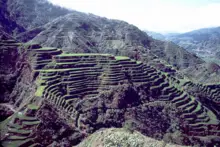Difference between revisions of "Banaue Rice Terraces" - New World Encyclopedia
Dan Davies (talk | contribs) (Banaue, Ifugao inserted, hidden) |
Dan Davies (talk | contribs) (Terrace (agriculture) imported, hidden) |
||
| Line 163: | Line 163: | ||
{{credits|Banaue,_Ifugao|185018505}} | {{credits|Banaue,_Ifugao|185018505}} | ||
| + | |||
| + | —> | ||
| + | |||
| + | <!-- | ||
| + | {{otheruses|terrace}} | ||
| + | {{Unreferenced|date=November 2007}} | ||
| + | |||
| + | [[Image:Rice terraces.png|thumb|right|[[Banaue Rice Terraces]], [[Ifugao Province]], Philippines.]] | ||
| + | [[Image:Terrace field yunnan china.jpg|thumb|right|Abstract pattern of terrace rice fields in [[Yunnan]] Province, southern [[China]].]] | ||
| + | |||
| + | In [[agriculture]], a '''terrace''' is a leveled section of a [[hill]]y cultivated area, designed as a method of [[soil conservation]] to slow or prevent the rapid [[surface runoff]] of [[irrigation]] water. Often such land is formed into multiple terraces, giving a stepped appearance. The human landscapes of [[rice]] cultivation in terraces that follow the natural contours of the escarpments like [[contour plowing]] is a classic feature of the island of [[Bali]] and the [[Banaue Rice Terraces]] in [[Benguet]], [[Philippines]]. In [[Peru]], the [[Tahuantinsuyu|Inca]] made use of otherwise unusable slopes by [[drystone wall]]ing to create terraces. This form of land use is prevalent in many countries, and is used for crops requiring a lot of water, such as rice. Terraces are also easier for both mechanical and manual sowing and harvesting than a steep slope would be. | ||
| + | |||
| + | Natural terracing, the result of small-scale erosion, is formed where cattle are grazed for long periods on steep sloping pasture. Sometimes, as a [[Glastonbury Tor]], the result is regular enough to give an impression of archaeological [[Artifact (archaeology)|artifact]]s. | ||
| + | |||
| + | From its origins in agriculture the practice of formally [[Terrace (gardening)|terracing]] a sloping site evolved in gardening. The [[Hanging Gardens of Babylon]] could have been built on an artificial mountain with stepped terraces like those on a [[ziggurat]]. At the seaside [[Villa of the Papyri]] in [[Herculaneum]], the villa gardens of Julius Caesar's father-in-law fell away giving pleasant and varied views of the Bay of Naples. | ||
| + | |||
| + | Terraces were also methods of soil conservation farming for the Inca. They used a system of [[canal]]s and [[aqueduct]]s, and made the water flow through dry land and helped them be fertile lands. | ||
| + | |||
| + | The Incas constructed the terraces on the slopes of the Andes mountains. They cut step-like ledges into the mountainside, so they could be used as field, where they planted crops. Using terraces also stopped the rain from washing away the soil. This technique was so successful, it is still used in the [[Andes Mountains]]. | ||
| + | |||
| + | In old [[English language|English]], a terrace was also called a [[lynch]] and there is a fine example of a ''Lynch Mill'' in [[Lyme Regis]], for which the water arrives via a river ducted along a terrace. This set-up was used in steeply hilly areas in the [[UK]]. | ||
| + | |||
| + | {{commonscat|Agricultural terraces}} | ||
| + | |||
| + | {{credits|Terrace_(agriculture)|221479917}} | ||
| + | |||
—> | —> | ||
Revision as of 17:13, 27 June 2008
| Rice Terraces of the Philippine Cordilleras* | |
|---|---|
| UNESCO World Heritage Site | |
 Banaue Rice Terraces, Ifugao Province, Philippines. | |
| State Party | |
| Type | Cultural |
| Criteria | iii, iv, v |
| Reference | 722 |
| Region** | Asia-Pacific |
| Inscription history | |
| Inscription | 1995 (19th Session) |
| Endangered | 2001- |
| * Name as inscribed on World Heritage List. ** Region as classified by UNESCO. | |
Te Banaue Rice Terraces (Tagalog: Hagdan-hagdang Palayan ng Banaue) are 2000-year old terraces that were carved into the mountains of Ifugao in the Philippines by ancestors of the Batad indigenous people. The Banaue terraces are part of the Rice Terraces of the Philippine Cordilleras, ancient sprawling man-made structures from 2,000 to 6,000 years old. They are found in the provinces of Apayao, Benguet, Mountain Province and Ifugao, and are a UNESCO World Heritage Site.
Description
The Rice Terraces are commonly referred to as the "Eighth Wonder of the World". It is commonly thought that the terraces were built with minimal equipment, largely by hand. The terraces are located approximately 1500 meters (5000 ft) above sea level and cover 10,360 square kilometers (about 4000 square miles) of mountainside. They are fed by an ancient irrigation system from the rainforests above the terraces.
Local Peoples
Locals to this day still tend to the rice and vegetables on the terraces, although more and more younger Ifugaos do not find farming appealing, often opting for the more lucrative hospitality industry generated by the Rice Terraces. The result is the gradual erosion of the characteristic "steps", which need constant reconstruction and care.
External links
| |||||||
[[Category:]]
Credits
New World Encyclopedia writers and editors rewrote and completed the Wikipedia article in accordance with New World Encyclopedia standards. This article abides by terms of the Creative Commons CC-by-sa 3.0 License (CC-by-sa), which may be used and disseminated with proper attribution. Credit is due under the terms of this license that can reference both the New World Encyclopedia contributors and the selfless volunteer contributors of the Wikimedia Foundation. To cite this article click here for a list of acceptable citing formats.The history of earlier contributions by wikipedians is accessible to researchers here:
The history of this article since it was imported to New World Encyclopedia:
Note: Some restrictions may apply to use of individual images which are separately licensed.

